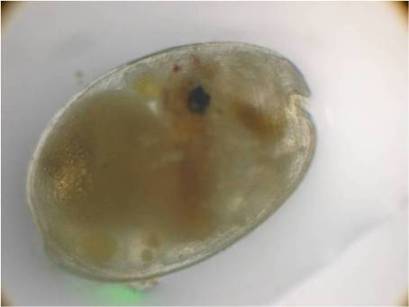Diet and Metabolism: The Process of Nutrition in Photeros annecohenae
Photeros annecohenae are
scavengers. They feed on dead animals
and begin to decompose this decaying organic matter. Because of
this, they are classified as detritivores,
or detritus feeders.
Photeros annecohenae feed on decaying fish,
shrimp
and other invertebrates (even other ostracods) of the tropical seagrass beds in which
they reside (Gerrish and Morin 2008). (It has not been observed that these ostracods
consume decaying plant matter, only that of animals (Gerrish
Personal Communication).) Because of this, they are attracted to carrion, or
fish carcasses (Torres and Morin 2007), and this has been helpful in their
obtainment for research studies. These scavenging ostracods are
night-feeders; they forage at night.
The high densities of Photeros annecohenae found in
their grassbed habitats indicates that their scavenging is
successful (They are able to find enough food.) and that they have a large impact on the environment
around them (Gerrish Personal Communication).
in
their grassbed habitats indicates that their scavenging is
successful (They are able to find enough food.) and that they have a large impact on the environment
around them (Gerrish Personal Communication).
Ostracods use a pair of appendages, their first
antennae, to sense the environment, including food sources.
They then use a second pair of appendages, their second
antennae, to move to their food by means of swimming, burrowing
and/or crawling. (This pair of antennae is also responsible for
allowing them to distinguish food sources from other matter they
intercept.) Because of the fact that ostracods must move to
their dead food sources, water velocity strongly affects their ability to acquire nutrients. Fewer juveniles and
adults are found foraging when the water velocity is high (Gerrish
2009);
this occurs because the ostracod’s ability to swim as well as
grasp food is hindered by strong currents. During times of
strong currents, the ostracods remain protected in their habitat
to avoid being swept away. A strong water current also decreases
Photeros annecohenae's
efficiency in detecting food since the current carries away
chemical cues that the ostracod would typically detect. It
appears that feeding behavior corresponds with reproductive
behavior in the fact that both are not as prominent during times
of strong water velocity (overall inactivity during these
periods) (Gerrish 2009). Both also occur at night.
 After taking in the dead animal material, it is grinded up and
moves through a straight-through digestive system that runs from
their mouth to their anus. The nutrients absorbed are then
circulated to their tissues via an open
circulatory system. Food is stored as
glycogen.
After taking in the dead animal material, it is grinded up and
moves through a straight-through digestive system that runs from
their mouth to their anus. The nutrients absorbed are then
circulated to their tissues via an open
circulatory system. Food is stored as
glycogen.
Although Photeros annecohenae is not a known parasite for any
organisms, it is a victim of parasitism and
serves as a host for copepods, an ectoparasite in the family Nicothoidae, which may
be found in the valves of the organism's carapace
(Gerrish Personal Communication).
This parasite is found in the brood of a female ostracod and feeds
off her eggs, replacing them with its own. The female releases
these eggs into the environment when it comes time for her to
release what she thinks are her own juveniles.
To learn more about this parasite and how Photeros
annecohenae interacts with other organisms, click
here!
